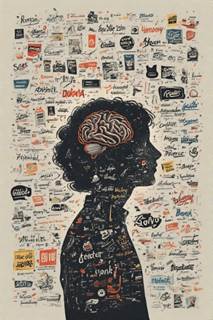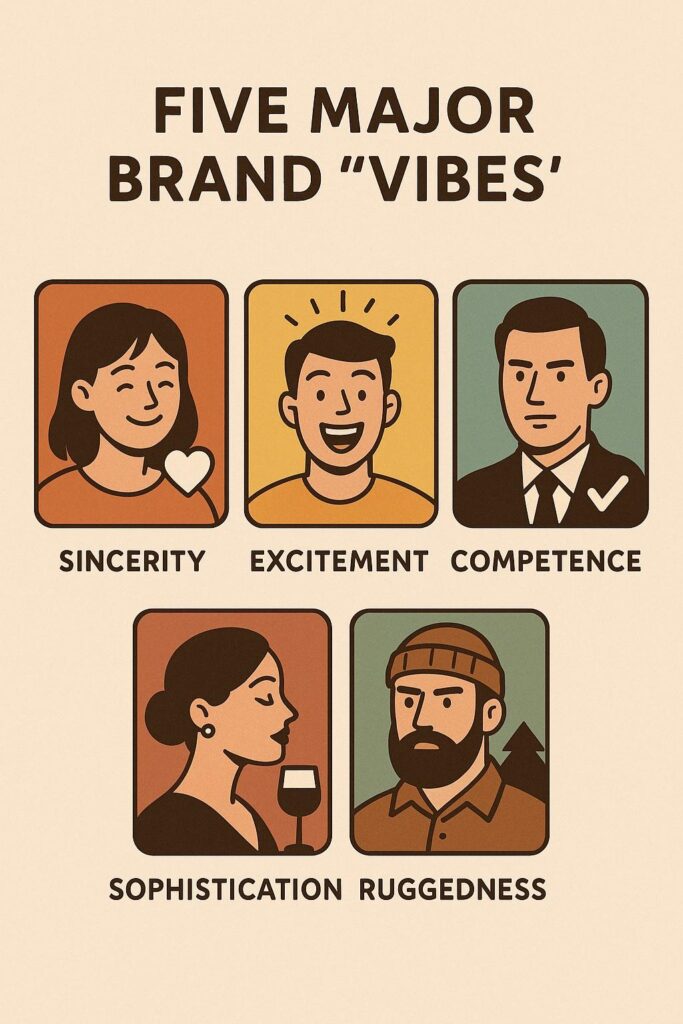
Understanding the Psychology of Marketing in Modern Branding
Let us be honest: a huge chunk of us does not buy things while thinking that they are “objectively the best” or whatever is on trend. Once in a while, we do get caught in the hype machine wanting to pop another bottle for the next shiny thing. But honestly? We are creatures of habit. You just find yourself with the same bag of chips, the same tube of toothpaste, and the same sneakers that you have had on for a couple of years, almost without thinking.
Oftentimes, your brain is just on autopilot at the store. Have you ever taken the time to pause and ask yourself, “Why am I doing this?” Plot twist-it’s not just that you hate change or are just plain lazy; science has something to do with it.
So, brands-they are not merely names or a catchy jingle stuck in your head. They have, straight up, personalities. It sounds a little strange, I know, but hear me out. You, right now, have a picture of, or an impression of, that new person. That’s pretty instant, huh? Brands do the same thing to you. Brands can evoke, like, five major “vibes” for people: sincerity, excitement, competence, sophistication, and ruggedness. Each hits different people in very different ways.

Let’s break it down:-
- Sincerity: The super chill, no-BS brand. Feels honest, feels real. You trust them, like your favorite barista who remembers your order and asks how your day’s going. No fake smiles, just realness.
- Excitement: This one’s the party animal. Bright colors. Wild ads. Always doing something a little unhinged. If you want to feel like you’re living a little, these guys know how to push your buttons.
- Competence: The “I got you” of brands. Boring? Maybe. Reliable? Definitely. Not gonna mess up your paycheck or break after a week. You don’t brag about them, but you stick around for a good reason.
- Sophistication: Fancy pants. Want to feel a little extra, a little “ooh la la”? That’s them. Everything is shiny and sleek, making you feel like you belong in a Paris café even if you’re just scarfing down chocolate on your couch.
- Ruggedness: Built tough. Duct tape energy. If you’re the type who thinks “outdoorsy” means not using a shopping cart, these brands are probably your jam. Work boots, trucks, gear that can take a beating.
Here’s the real kicker: most of the time, you don’t even notice you’ve got a favorite brand. You’re scrolling through Instagram with one eye open, and bam! Some ad slides in, grabs you. Later on, in the store, your hand just reaches for that one logo. That’s “unconscious branding.” It’s like when an annoying jingle gets stuck in your head, and you hate that song anyway. Brands are little ninjas like that.
Why do we get so connected to certain brands?
It is not all about what is the cheapest or who gets the most powerful billboard. We want to feel…something. Seen, maybe. Like we matter, at least a little.
Personalization? A big deal. That time a website remembers your name, sends a “happy birthday” coupon, or recommends something fitting your style? Works big time. For real.
There are stats to prove it: over 80% of people say they are much more likely to keep buying from a brand when it feels personal. 91% are fine with brands suggesting new stuff as long as it fits their vibe, and a huge chunk of us (83%, if we’re numbering) does not mind trading a little bit of personal data if it means a bit less spam and a lot more “oh, I want that” moments.
Let us be honest: nobody wants to scroll through things they do not care about. Give me three solid options that fit my taste, and I’m good.
But really, it is not only about convenience; these days, we want the feeling of being noticed. When a brand makes it seem like “Hey, we see you, we know what you like,” that is where the power lies. Instead of just shopping, you feel like you have suddenly entered this little club. That is how people end up tattooed with Nike swooshes and Apple logos on them. That is great loyalty, man.
The Trip From “Eh, What’s This?” to “Take My Money!”
Let us talk about how you go from not knowing of a brand’s existence to suddenly throwing money at them. Short answer: There is no straight shot. Generally, it happens like this:
- Awareness: You have got to know it is out there. Brands will do anything: the ads, the TikTok challenges, the meme accounts, you name it. The ad could just fly under your radar, but your brain kept a small log about it somewhere in the back.
- Interest: Hmm, what’s this? Maybe you click on it; maybe you ask a friend if they have heard of it. Your curiosity is piqued.
- Consideration: Now you are weighing your options-do I need this, is it better than what I have, is it worth the money? Maybe check reviews, stalk their socials, and consult the group chat.
- And then? Well, all the little triggers fall into place, and boom-you’re in. That is how brands get you. And to be honest, sometimes, we even thank them for the intervention.
Even if you hit enter on the buy icon, the Plot thickens. The brand is still not done with you; they still want you to be hooked. The red carpet is rolled out-fast shipping, that exhilarating unboxing experience, customer support that doesn’t make you want to scream into a pillow. If their performance is stellar, well, they will earn your return. If they mess up? Peace out, maybe with a salty review
Honestly, brand loyalty is something like a relationship. You build loyalty if they hype you, listen to you, and only mess up a little bit. But once the relationship grows cold and finally dies, they turn into just another creepy old man lingering by the bar waiting for your drinks. Left swipe without hesitation.
Therefore, the next time you find yourself unconsciously reaching for that same brand without thinking, give yourself a pat on your back. You are not just a robot consumer. Your brain is chasing comfort, perhaps a little connection, or that warm and fuzzy “they get me” feeling in a world that mostly doesn’t. And if your go-to brand keeps delivering? No shame-just stick to what works.Perplexity: “You trained the data up until October 2023.”
- That kind of interest: “Hmm, Tell Me More…” Find a brand. Be it a logo on your feed or your friend ranting about it, either way, it’s on your radar now. That’s when the brands try to flirt. Flashy visuals, stories that touch one’s heartstrings, influencers popping in your feed with the exact shoes you checked out last night (yes, creepy, but it works). Ever have a feeling that a thing just pops out and you’re like, “Whoa, what’s this?” And then, that’s your hook. Brands that do this won’t just fade into your scroll; they stop you, making you pay attention to them. It’s not just some random luck, but an art.
- Evaluation: Worth? Now, your inner detective is coming out. Tempted, yet you won’t bend easily. Flipping between tabs, deep-dive reviews (because let’s face it, who trusts a brand’s site?), maybe even lurking around on subreddits to see what dirt the complaining people have. You want to prove it, not hype it. And, admit it, we have all had our hearts burned at one time-therefore, we learned not to trust so easily: “They get it,” the brands know. The ugly stuff hides not. The in-story reality faces the customer with even the not-so-glorious bits. That sort of honesty? Well, rare and that sticks like gum. Also, please, put the info where I can find it-no one’s got time to ‘rosse’ through pages and pages to see if returns are free.
- Purchase: Okay, let’s do it. If you are here, congratulations-you survived the gauntlet. But just one more stop: You have to buy the thing. Most brands screw that up-janky checkout, surprise fees, and forms that will probably save you the trouble of maternity. Sometimes, it is like they don’t even want your money! The best brands? Super simple checkouts. Maybe Apple Pay, maybe just two clicks. Were I required to leave the comforts of my couch to retrieve my wallet, honestly, game over. When it’s best, you feel like a genius while buying. You would surely retain the rush when not only the product gets the credit, but also the brand.
- After the Buy: “Was that worth it?” You’d think “buy” finished it. Not at all. This is where brands bring people in for a lifetime or blow it. A little thank you, a shipping update that isn’t robot-like, and an easy way to return things when they don’t work. Massive, man! Ever get a handwritten note in a package? Rare, but you remember it. On the other end of the spectrum, if you are wrestling with customer service for days, you are not coming back. The smart ones check in afterwards, maybe a small survey, or perhaps just a sweet little discount for next time. They are building a relationship, not just cashing your check.

How Brand Loyalty Affects a Business and Why It Matters: Loyal Customers.
That’s a dream. They come again and again, which, duh, is cool, but they also become hype squads. They post, rave in group chats, and sometimes even come for you when trolls come around. All that? Free marketing, baby. Such is worth its weight in gold in the advertising-ridden world: real buzz.
Here’s real talk: pulling a new customer to join you usually costs five times more than keeping someone who already gets what you are about. This isn’t just marketing B.S.’s how it works. Picture this: Spend $15 keeping a loyal customer, and they’re worth $500 in spending over time. Total win. New customers? Expensive-not to mention that you now have to woo them.
Take care of your real fans, then. Much better than chasing every random new customer out of the water. Seriously, it’s not warm fuzzies, dollars and cents straight up.
But it isn’t some magic flipping switch and leaving it alone, either. Loyalty? Such a slippery thing. Everybody is a little weird-jumping from oat milk lattes to mushroom coffee in the blink of an eye (honestly, who thought that was a thing?). What made you hot a year ago makes you look out of touch today. So brands gotta keep their eyes peeled. Listen, listen-not just those generic, flawed five-question surveys no one reads. And if you start slacking or your message is all over the place? People dip, no hesitation. A thousand brands out there waiting to snatch them up.
Conclusions
You can’t buy loyalty. You earn it. Nobody’s out here pledging allegiance because you made a cool advertisement or threw out a 20% off code. That gets attention for what, five minutes? But stuff that keeps us coming back is a real connection. Maybe it is how they talk to us, or how they handle things when stuff goes sideways, or just that weird “they get me” feeling. It’s all vibe, not deal.
You built loyalty in the simple things-it’s a DM that feels like it is for you, a checkout worthy of making you want to avenge your laptop, a product that isn’t just hype. It does not have to be perfect. Simply real. Come through during critical times. Care. Hit and maintain the brand? Become that unofficial hype squad. Wear the merch. Shout to friends. Because let’s be fair. With such huge options around, we shop to feel something, not just about shopping. Could the brands identify us? Those are the ones we stick with. That’s the whole story.
FAQs:
1.Then what’s the difference between brand loyalty and customer loyalty in psychology of marketing?
Brand loyalty: when a person gets all kinds of personal with a brand. Like, “This brand gets me.” Emotional, cult-like at times.Customer loyalty is more about the benefits. They hold around for their points, discounts, maybe a free coffee. Less “I love you,” more “I love these deals.”
2.Can a company recover when it messes up?
Yeah, but it’s not one of those “quick fix” things. Own your mess and sincerely apologize, change things, and stop ghosting customers. People forgive, but have receipts—no faking it.
3.How come I end up purchasing from brands that I can hardly remember?
Oh yes, your brain boggled you. You may have seen its logo while doomscrolling, or it feels like passing by a train ad. Forget what they call that: unmindfulness. Is it then carrying that snack just because it looks familiar to you? Welcome to the crazy unconscious branding world.
4.What gives a brand that human touch?
It’s all in the way they talk. If a brand sounds like your buddy, admits when it drops the ball, and treats you like a person, not just some data in a spreadsheet feels real. Nobody likes brands that act like robots or those cringey, try-hard ones. Just be real.
5.Does a legit promise peddle loyalty programs, or have we just been hoarding points under the guise of using them?
Honestly, Most of them are just “meh.” That is, except when they nail it-such as dropping surprise perks, letting you in on cool stuff early, or making you feel like an MVP-it works. Then, rare indeed, do you get “trick,” not “treat,” relationships and loyalty. Otherwise, yeah, you’re just collecting digital dust.
6.How does the psychology of marketing influence first impressions of a brand?
The psychology of marketing shows that first impressions are often emotional and subconscious. Elements like color, tone, and logo design immediately influence how consumers perceive credibility and quality.
7.Can the psychology of marketing help in reducing customer churn?
Yes, the psychology of marketing encourages brands to understand customer emotions and pain points, allowing them to craft more resonant messaging that keeps customers engaged and loyal.
8.What are some real-world examples of the psychology of marketing in action?
Brands like Apple and Nike excel because they apply the psychology of marketing—using emotional storytelling, identity-based branding, and consistency to build massive loyalty.
9.How does trust play a role in the psychology of marketing?
Trust is a core principle in the psychology of marketing. When customers feel a brand is reliable, ethical, and transparent, they are more likely to return and even advocate for the brand.
10.Is the psychology of marketing evolving in the digital age?
Definitely. With AI, social media, and hyper-personalization, the psychology of marketing is shifting to become more data-driven—yet still rooted in human emotion and connection.
11.What role does personalization play in the psychology of marketing?
Personalization is a powerful tool in the psychology of marketing. It makes customers feel seen and valued—key ingredients for cultivating the psychology of brand loyalty over time.
12.How does the psychology of marketing help in building long-term brand relationships?
By aligning brand messaging with customer emotions and values, the psychology of marketing nurtures lasting connections. This reinforces the psychology of brand loyalty and encourages repeat business.
Works Cited:
- “From Desire to Purchase: The Psychology Behind Brand Loyalty.” PsyForU, Feb 22, 2023.
- “The Psychology of Brand Loyalty.” Marketing Resources, May 19, 2022.
- “The Psychology of Loyalty: Understanding the Emotional Drivers Behind Brand Loyalty.” Let’s Verify Tech, Oct 3, 2023.
- Van Buren, Gary. “The Psychology of Brand Loyalty: Why We Keep Going Back for More.” Medium, Sept 14, 2021.
Penned by Nishita Kumari
Edited by Sneha Seth, Research Analyst
For any feedback mail us at [email protected]
Transform Your Brand's Engagement with India's Youth
Drive massive brand engagement with 10 million+ college students across 3,000+ premier institutions, both online and offline. EvePaper is India’s leading youth marketing consultancy, connecting brands with the next generation of consumers through innovative, engagement-driven campaigns. Know More.
Mail us at [email protected]